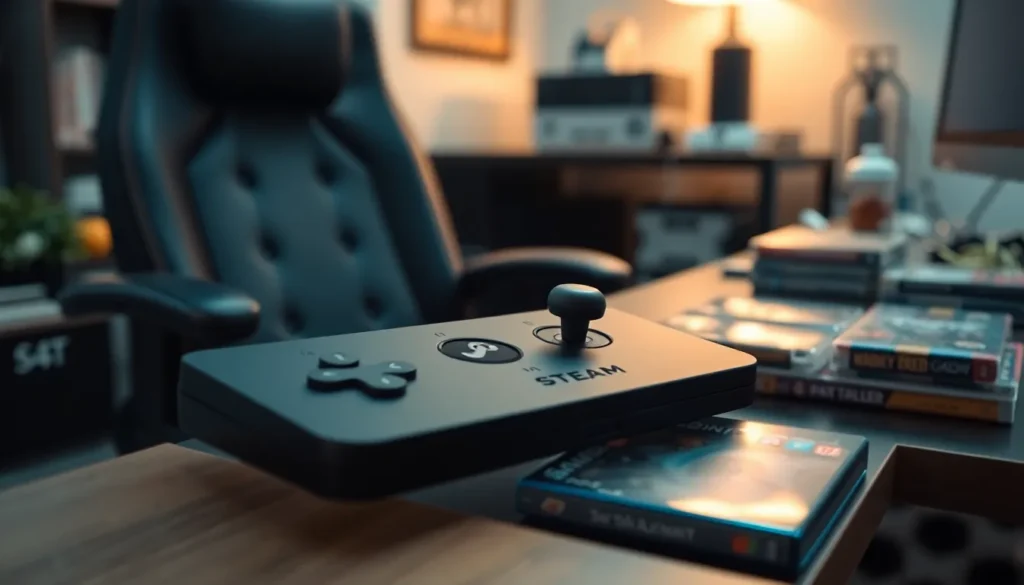The Steam Deck isn’t just a handheld gaming marvel; it’s a canvas for creativity and customization. Ever found yourself wrestling with controls that just don’t feel right? Fear not! Remapping your Steam Deck is like giving your gaming experience a much-needed makeover. Imagine your favorite game responding exactly how you want it to—like a well-trained puppy that fetches your slippers instead of chewing them.
Table of Contents
ToggleOverview of Steam Deck Remapping
Steam Deck remapping allows players to customize the controls of their device, resulting in a tailored gaming experience. This essential feature enhances gameplay by providing flexibility in control configurations.
What is Steam Deck Remapping?
Steam Deck remapping involves changing the default button assignments of the device. Users can assign actions to different buttons, adjust sensitivity settings, and even program custom control schemes. Such modifications provide players the freedom to create a layout that feels natural and intuitive. This functionality supports various game genres, accommodating preferences whether for first-person shooters or role-playing games.
Why Is Remapping Important?
Remapping plays a crucial role in optimizing gameplay experiences. Personalized control schemes can increase comfort and performance during extended gaming sessions. Custom layouts help accommodate different playstyles, ensuring each player can find the configuration that best suits their needs. Enhanced accessibility becomes possible through remapping, allowing players with specific requirements to enjoy games comfortably. By emphasizing control customization, Steam Deck ensures that every gamer can enjoy fluid, responsive gameplay tailored to individual preferences.
How to Remap Controls on Steam Deck

Remapping controls on the Steam Deck allows players to personalize their gaming experience. This process enhances gameplay by aligning control schemes with individual preferences.
Accessing the Remapping Features
Accessing remapping features on the Steam Deck is straightforward. Start by navigating to the Steam Library. After selecting a game, press the “Steam” button on the device. Choose “Manage” from the options, followed by “Controller Configuration.” This section showcases various control settings available for adjustments, giving players the tools they need to refine their control layout.
Step-by-Step Remapping Process
Follow a simple step-by-step process to remap controls effectively. First, select the button you wish to change. Next, choose what action to assign, such as a jump or shoot command. Players can also adjust sensitivity settings for analog sticks and triggers. Save the new configuration once complete, and test the layout in gameplay. This ease of customization allows players to create an experience tailored to their needs.
Tips for Effective Remapping
Effective remapping enhances control schemes, ensuring a tailored gameplay experience. Players can maximize their enjoyment by utilizing different approaches based on game styles.
Custom Layouts for Different Games
Creating custom layouts benefits gameplay across various genres. Players often experiment with different button configurations for action games compared to simulation titles. Assigning game-specific functions streamlines actions, resulting in improved responsiveness. Adapting layouts enhances comfort during long sessions, allowing seamless transitions between different titles. Utilizing profiles saves time, as switching layouts becomes as easy as selecting a game. Players should consider their play style when configuring controls, as personal preference significantly influences gameplay satisfaction.
Using Third-Party Software
Third-party software options can enhance the remapping process. Tools like Steam Input provide advanced features beyond default settings. Using these programs allows for further customization, including macros and complex input combinations. Gamers also gain access to community-shared configurations, offering inspiration and ready-made setups. Researching specific applications ensures compatibility with the Steam Deck’s features. Players should remain mindful of potential performance impacts, maintaining optimal functionality during gameplay. Exploring these options can elevate the remapping experience significantly.
Common Issues and Troubleshooting
Identifying common issues with Steam Deck remapping helps players troubleshoot effectively. Input lag and configuration errors are two prevalent concerns.
Resolving Input Lag Problems
Input lag can hinder gameplay responsiveness. Players might experience delays between button presses and in-game actions. Adjusting sensitivity settings usually mitigates this issue. Lowering sensitivity often results in a snappier response time. Additionally, using wired connections instead of wireless ones can enhance performance. Players should test configurations in less demanding games to isolate lag issues. Save configurations frequently to prevent loss of optimal settings.
Fixing Configuration Errors
Configuration errors can disrupt the gaming experience. Players might face issues with unresponsive controls or incorrect button assignments. Restarting the Steam Deck often resolves unexpected behavior. Accessing the “Controller Configuration” menu allows players to verify button mappings. Checking for software updates can also rectify configuration glitches. If problems persist, restoring default settings frequently resolves deeper issues. Finally, utilizing community forums can provide quick solutions from fellow players who faced similar challenges.
Steam Deck remapping opens up a world of customization that enhances the gaming experience. By allowing players to tailor control schemes to their preferences it ensures comfort and responsiveness during gameplay. The ability to create unique layouts for different genres not only improves performance but also accommodates various play styles.
With straightforward remapping options and the potential for advanced customization through third-party software players can truly make the Steam Deck their own. Addressing common issues like input lag and configuration errors further enhances the overall experience. Embracing these remapping features can lead to a more enjoyable and immersive gaming journey.








